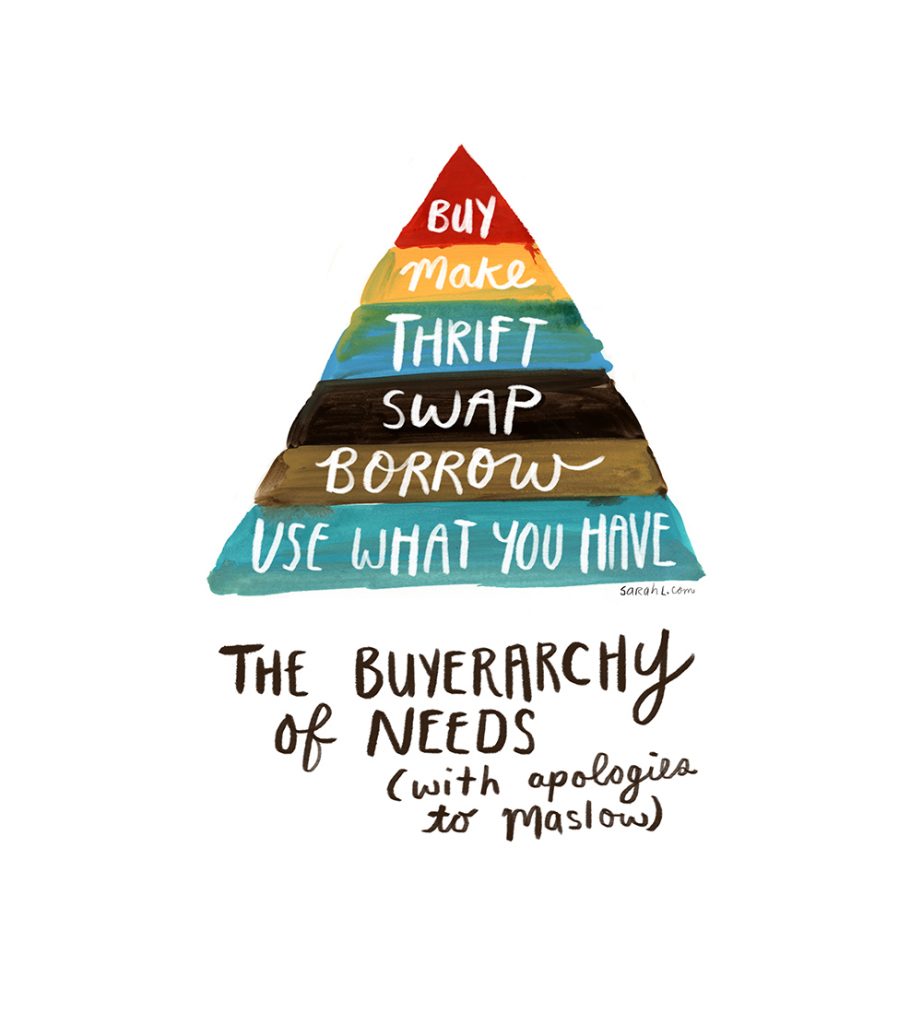
How to Be a Conscious Consumer: Use Your Purchasing Power for Good
If you're following along or reading this post, you're interested in making conscious and ethically-informed decisions as a consumer. There are a lot of ways to achieve this, and there is always room for progression and growth- nobody (and I repeat, nobody) is perfect. It's like everything in life.
There are plenty of resources easily available surrounding sustainability in production and consumption. A good place to start is Sarah Lazarovic's "The Buyerarchy of Needs".

"The Buyerarchy of Needs" by Sarah Lazarovic
First of all, consume less. Use what you have, borrow, swap, thrift, make, and then, as a very last resort, buy. Why? Well, the average American wastes nearly 1 million pounds of materials per person every year. This figure includes 3.5 billion pounds of carpet landfilled, 19 billion pounds of polystyrene peanuts and 28 billion pounds of food discarded. Less than 2% of this total waste is recycled.
This figure also includes the 13 trillions tons of clothes Americans send to landfills every year. This is 68 pounds of clothing per person. The majority of these clothes take 200+ years to decompose and leach toxic chemicals and dyes, which contaminate local soil and groundwater.

When you do consume, consume slow (fashion). The slow fashion movement as we know it today arose directly as a response to fast fashion and its inherent problems related to sustainability. The term "slow fashion" was coined by Kate Fletcher of the Centre for Sustainable Fashion.
Slow Fashion is an awareness and an approach to fashion focusing on sustainability as it relates to the environment and socio-economic conditions of workers. Processes and resources required for production are considered, with focus on fair treatment of people, animals and the planet.

Support environmentally-sustainable brands that value transparency and accountability. The Good Trade is a great resource and has a thorough list here. For example, purchase clothing made from natural fibers such as organic cotton, jute, hemp, silk, linen or sisal. Synthetic fibers release microplastics and chemicals into watersheds and can take up to fifty years or more to decompose. Also consider the amount of water used to produce your clothing, the carbon footprint of harvesting/growing the raw materials, and how far it had to travel to reach you.
This logic extends beyond just clothing to home goods, accessories, jewelry and more. Anytime you utilize your purchasing power, consider using it for good.

In addition to environmental impact, be aware of the ethical and moral aspects of production and delivery. I.e. Ask yourself, who made this? How was it made? Slavery, child labor, indentured servitude, unreasonable wages, pollution, suppression or prevention of labor unions, animal testing, globalization and inequalities of development are all of concern. That list is not exhaustive, either.
Approximately 75 million people work to make our clothes. 80% of them are women between the ages of 18 and 35. The majority of these people live in poverty and many are subject to unsafe working conditions, abuse and exploitation. Fashion Revolution is an excellent resource for consumers interested in the socio-economic conditions of production.

At Thread Spun, we support small-scale, handmade production, fair wages and fair trade around the world because we care about sustainability in consumption. We believe that in a market economy, consumers will make purchases. We also believe that we can reduce our consumption whilst also supporting socially and environmentally sustainable brands and making ethical purchases.
Learn more about our mission to offer our customers handmade and fair trade goods, our artisan partners and our charity partner here. Then, shop our sustainable goods for the better good, including home goods, apothecary and accessories.

Reversible, foldover clutch handmade by resettled refugee women in San Diego, California.
